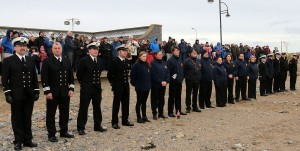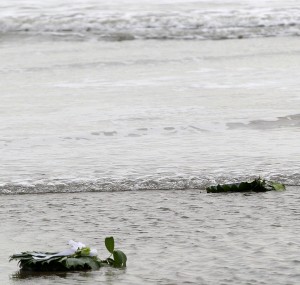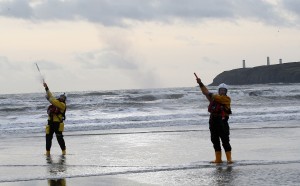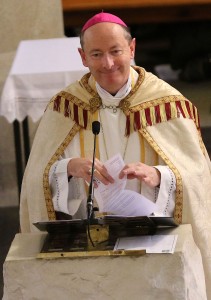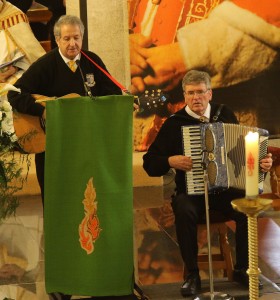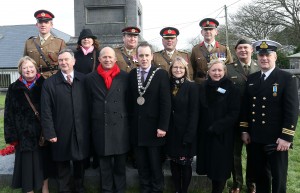
Waterford City and County Mayor John Cummins and British Ambassador Dominick Chilcott pictured with members of the Duke Of Lancasters Regiment together with Eddie Murphy (Lt Commander Irish Navy), Maxine Keoghan, Tracey McEneaney (Chair, Seahorse Committee) and Paul Brent (Seahorse Committee) pictured at the Seahorse Obelisk on Saturday last. | Photos: Jim O'Sullivan
Kieran Walsh reports
Hundreds turned out in Tramore on Saturday last to mark the 200th anniversary of the Sea Horse maritime disaster, which claimed 363 souls in Tramore Bay.
An ecumenical service was held at the Holy Cross Church while a wreath laying ceremony at the Church of Ireland at Christ Church.
This was followed by a Mayoral address, where City & County Mayor John Cummins acknowledged the British Ambassador to Ireland, Dominick Chilcott, for attending the commemoration events.
Also in attendance were members of the Irish Defence Forces, and the officers of the Duke of Lancaster’s Regiment in the British Army; this was the regiment, returning from France after the wars with Napoleon and Waterloo Battle, who lost their lives in Tramore Bay.
The Organisation of National Ex-Servicemen, including a Carrick contingent and members of the British Legion were also present.
Catholic Bishop of Waterford & Lismore, Alphonsus Cullinan spoke earlier at Holy Cross Church, with Church of Ireland Reverend Dean Maria Jansson leading the prayers at Christ Church.
Overseas visitors included representatives of the Lancashire Infantry Museum and the descendants of those who were on board the Sea Horse on that fateful day.
The dreadful tragedy occurred when high tides and an unexpected storm left if impossible for sailing vessels to seek shelter along the shoreline.
Within a 24 period, a convoy of ships which included, the Boadicea, the Lord Melville and the Sea Horse, all foundered with a loss of more than 600 lives, making it one of Ireland’s greatest maritime disasters. The convoy of ships was bound for Cork at the time.
The men, women and children on board the ships were returning home to their barracks in Cork where many of them had enlisted.

British Ambassador Dominick Chilcott and Waterford City & County Mayor John Cummins laying wreaths at the Seahorse Obelisk at Christ Church Tramore.
Although it may seem surprising today, it was customary for the infantry in 1816 to be accompanied by their wives and children.
The men and their families had returned from France where they had taken part in the wars against Napoleon.
They had endured many hardships over the previous few years and no doubt, they looked forward to returning home to recover and return to a life without war.
Unknown to the passengers, as they left Ramsgate in England in late January, their voyage home was to be their last and final journey. Sadly, the men, women and children of the Sea Horse never made it home.
The Sea Horse, in an attempt to reach the safety of Waterford Harbour, found it impossible to round Brownstown Head and regrettably the ship broke apart in Tramore Bay.
Of the 393 passengers on board that day, 363 perished and only 30 of the strongest survived.
Tramore was to be the final resting place of the men, women and children of the 59th Regiment and it is to this present day that the story of the Sea Horse tragedy is synonymous with Tramore and indeed its people.
Last Saturday’s commemoration is further a time to remember the people of Tramore whose descendants attempted to rescue those on board the Sea Horse. One local Tramore man saved 11 men and was later recognised in the Westminster Parliament for his efforts.
He was but one of many; the fishermen and townspeople of Tramore, all attempted to help during the disaster.
British Ambassador Dominick Chilcott listed a number of local name of rescuers like Kirwan.
AP Hunt was the local hero, who rescued many. Others were Burke, Dunne, Dunphy, Morrissey, Kent, Phelan, Power, Walsh and more.
Their descendants were thanked by the Ambassador for their efforts, many were present both in the Church graveyard, where wreaths were laid at the Obelisk.
A harrowing story was told of how James Gibb, a survivor clung to wreckage, his wife said goodbye and went down with her baby, they could not all hang onto the plank of wood.
It was a harrowing story to hear on a cold winter’s day.
The Ambassador spoke eloquently and recalled a previous visit to Tramore to the RNLI station three years ago with the Duke of Kent, where he learned of the Sea Horse anniversary plans and complimented the people of Tramore for marking the anniversary.
He noted the book on the tragedy by Maxine Keoghan and the organisation of the event by Tracy McEneaney (former Tramore Librarian), which he described as excellent.
Mr Max Walker attended as Defence Attaché while the Irish Army, Irish Navy and British Army also participated in the ceremony.
Mayor Cummins stressed that it was in this spirit of rescue, that the present day coastal rescue services have evolved.
It is impossible to imagine now how the small community of Tramore responded to the tragedy at the time – it must be remembered that the population of Tramore in 1816 hardly exceeded the number of people on board the Sea Horse itself.
The difficulties the town faced after the tragedy must have been enormous and it is due to the scale of the disaster that the stories of the Sea Horse have been passed from one generation to the present day.
The Last Post was played after a wreath laying ceremony in the graveyard, followed by the piper’s lament, the national lament and colour party march.
Down on the beach, the Irish Coast Guard performed a fly over in their Rescue 117 Search And Rescue Helicopter.
A red flare was set off, followed by a wreath laying ceremony in the Bay with the following groups participating: the Bonmahon Inshore Lifeboat, Irish Water Safety, Order of Malta, the RNLI, Tramore Cliff and Mountain Rescue and Sea Rescue Association.
The Cairn Stones were blessed with a piper’s lament, which featured Tigerlily Koeghan, Pat Murphy and John Stone concluding it.
ECUMENICAL CEREMONY held to mark 1816
A very moving ecumenical ceremony took place in the Holy Cross Church with the following officiating clergy: Bishop Alphonsus Cullinan, Rev Maria Jansson, Monsignor Nicholas O’Mahony, Fr Michael Toomey and Fr Shane O’Neill PP.
There was excellent singing provided by both the Waterford Male Voice and Tramore Ladies Choirs.
The lifeboat song was particularly memorable, while Vanessa Whelan sang a psalm as a soloist. Donncha Ó Maidín played the pipes while flautist Aine McCarthy Kent performed ‘The Coolin’ with Jonathan Power on organ duties.
Bishop Cullinan spoke about the power of the sea in his address – he had lived in Lahinch before and knows power of the sea.
The sea has beauty, immensity, merciless power and gentle silence, but there was no silence on that fateful day, with strong winds and choppy waters. The ship’s tragedy makes us think today, how we can reach out to those less fortunate, he added.
There are other human tragedies now, he said, perhaps in reference to the loss of life off Greece.
He also mentioned the problem of the homeless and child labour in the world today.
Tramore has three mass graves which underline the extent of the tragedy – at Drumcannon, Church Road and the Beach area.

